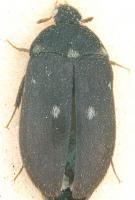Adult
Size
3.5 to 6.5 mm long. As in the case of many stored goods pests, adult and larva sizes can vary; they directly depend on food availability, nutrient richness and larval competition.
Aspect
Elongate oval body, about 2.25-fold more in length than in width, round at the ends.
Small head, slightly protruding from the prothorax, with one median ocellus on its front.
Males and females have 11-articled antennae, the last 3 articles form a quite clearly differentiated club.
Colour
Uniform very dark brown to black. Elytra slightly less dark than pronotum. The ventral face is black and covered in downy, short, fine, greyish bristles. Attagenus pellio is easily recognisable and can easily be told from related species thanks to the presence of 3 whitish spots (2 lateral ones and 1 median one) at the base of the pronotum, and 1 in the middle of each elytron.


 Attagène des peaux, Attagène des pelleteries, Dermeste des pelleteries
Attagène des peaux, Attagène des pelleteries, Dermeste des pelleteries  Two-spotted carpet beetle
Two-spotted carpet beetle  Gorgojo dos manchas de las alfombras
Gorgojo dos manchas de las alfombras  Gefleckter Pelzkäfer
Gefleckter Pelzkäfer 